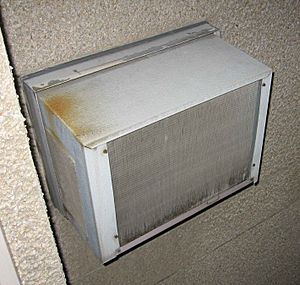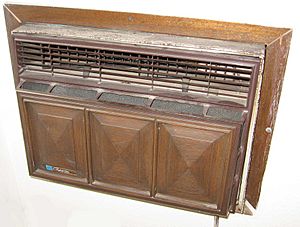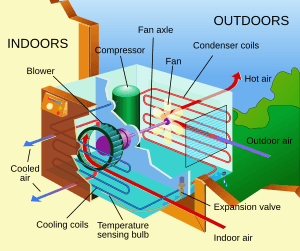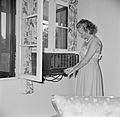Air conditioner facts for kids
Air conditioning (also called AC or air con) is a way to remove heat and moisture from a room. It makes the air inside a building or car feel more comfortable. AC is used in homes, offices, and many other places.
This process helps people and animals feel better when it's hot. Air conditioning also cools down rooms with lots of hot electronic devices. For example, it keeps computer servers and power amplifiers from getting too hot. It can also protect delicate items like artwork.
Air conditioners use a fan to spread cool air around a space. This helps make the air feel better and improves its quality. AC units come in many sizes. Some are small enough to cool a single bedroom. Others are huge systems on top of buildings that can cool an entire skyscraper.
Most air conditioners cool air using a special process called a refrigeration cycle. This cycle moves heat from inside to outside. Sometimes, cooling happens through evaporation (like sweat cooling your skin). Other times, "free cooling" uses cool outside air. Some AC systems use chemicals called desiccants to remove moisture. Also, some systems store or release heat using pipes buried underground.
In building design, a full system that includes heating, ventilation, and air conditioning is known as HVAC.
Contents
History of Air Conditioning
Scientists have been trying to cool air for a long time. In the 1800s, a British scientist named Michael Faraday made an important discovery. He found that if he squeezed and then let ammonia evaporate, it could chill the air.
Later, in 1842, a doctor from the Philippines named John Gorrie used a compressor to make ice. He used this ice to cool the air for his patients. Dr. Gorrie even dreamed of using his ice-making machine to cool entire cities!
How Air Conditioning Is Used
Air conditioning is used for two main reasons: to make people comfortable or to help a specific process.
Comfort Cooling
Comfort applications are all about making indoor spaces feel good for people. These systems keep the temperature and humidity steady. They do this even when the weather outside changes a lot or when many people are inside.
Process Cooling
Process applications are different. They create the right environment for industrial or commercial tasks. This is important for things that need very specific conditions to work well.
Here are some examples of process cooling:
- Hospital Operating Rooms: Air is highly filtered to stop infections. Humidity is controlled to keep patients from getting too dry.
- Cleanrooms: These rooms are used to make things like computer chips and medicines. They need extremely clean air and very precise control of temperature and humidity.
- Animal Breeding Facilities: Some animals only have babies in spring. By keeping rooms spring-like all year, these animals can reproduce more often.
- Aircraft Air Conditioning: Airplanes need special AC. It keeps passengers comfortable and cools equipment. It also deals with the very low air pressure outside the plane.
Other places that use process cooling include:
- Data centers (for computers)
- Textile factories
- Areas where plants are grown
- Mines
- Food processing areas
In both comfort and process uses, AC systems control more than just temperature. They also manage humidity, how air moves, and the quality of the air.
Health and Air Conditioning
Air conditioning can affect our health, just like heating systems. If large AC systems are not cleaned well, they can sometimes spread tiny living things. One example is Legionella pneumophila, which causes Legionnaires' disease.
However, air conditioning can also be helpful. It can be good for people with allergies and asthma by filtering out dust and pollen.
During very hot heat waves, air conditioning can even save lives, especially for older people. Some cities even open public cooling centers. These are places where people without AC at home can go to cool down.
Related pages
Images for kids
-
Willis Carrier, who is credited with building the first modern electrical air conditioning unit
See also
 In Spanish: Acondicionador autónomo para niños
In Spanish: Acondicionador autónomo para niños












